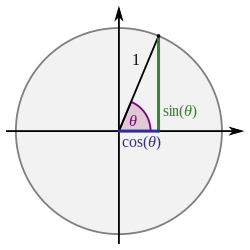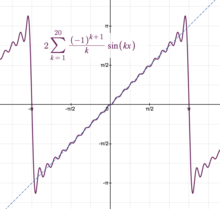| Trigonometry |
|---|
 |
| Reference |
| Laws and theorems |
| Calculus |
| Mathematicians |
In mathematics, trigonometric series are a special class of orthogonal series of the form[1][2]
where is the variable and and are coefficients. It is an infinite version of a trigonometric polynomial.
A trigonometric series is called the Fourier series of the integrable function if the coefficients have the form:
Examples
[edit]
Every Fourier series gives an example of a trigonometric series. Let the function on be extended periodically (see sawtooth wave). Then its Fourier coefficients are:
Which gives an example of a trigonometric series:

However, the converse is false. For example,
is a trigonometric series which converges for all but is not a Fourier series.[3][4]
Uniqueness of trigonometric series
[edit]The uniqueness and the zeros of trigonometric series was an active area of research in 19th century Europe. First, Georg Cantor proved that if a trigonometric series is convergent to a function on the interval , which is identically zero, or more generally, is nonzero on at most finitely many points, then the coefficients of the series are all zero.[5]
Later Cantor proved that even if the set S on which is nonzero is infinite, but the derived set S' of S is finite, then the coefficients are all zero. In fact, he proved a more general result. Let S0 = S and let Sk+1 be the derived set of Sk. If there is a finite number n for which Sn is finite, then all the coefficients are zero. Later, Lebesgue proved that if there is a countably infinite ordinal α such that Sα is finite, then the coefficients of the series are all zero. Cantor's work on the uniqueness problem famously led him to invent transfinite ordinal numbers, which appeared as the subscripts α in Sα .[6]
See also
[edit]Notes
[edit]- ^ Hardy & Rogosinski 1999, pp. 2, 4.
- ^ Zygmund 1968, pp. 6–7.
- ^ Edwards 1979, pp. 158–159.
- ^ Edwards 1982, pp. 95–96.
- ^ Kechris, Alexander S. (1997). "Set theory and uniqueness for trigonometric series" (PDF). Caltech.
- ^ Cooke, Roger (1993). "Uniqueness of trigonometric series and descriptive set theory, 1870–1985". Archive for History of Exact Sciences. 45 (4): 281–334. doi:10.1007/BF01886630. S2CID 122744778.
{{cite journal}}: CS1 maint: postscript (link)
References
[edit]- Bari, Nina Karlovna (1964). A Treatise on Trigonometric Series. Vol. 1. Translated by Mullins, Margaret F. Pergamon.
- Edwards, R. E. (1979). Fourier Series. Vol. 64. New York, NY: Springer New York. doi:10.1007/978-1-4612-6208-4. ISBN 978-1-4612-6210-7.
- Edwards, R. E. (1982). Fourier Series. Vol. 85. New York, NY: Springer New York. doi:10.1007/978-1-4613-8156-3. ISBN 978-1-4613-8158-7.
- Hardy, G. H.; Rogosinski, Werner (1999). Fourier series. Mineola, N.Y: Dover Publications. ISBN 978-0-486-40681-7.
- Zygmund, Antoni (1968). Trigonometric Series. Vol. 1 and 2 (2nd, reprinted ed.). Cambridge University Press. MR 0236587.








![{\displaystyle [-\pi ,\pi ]}](https://wikimedia.org/api/rest_v1/media/math/render/svg/cb064fd6c55820cfa660eabeeda0f6e3c4935ae6)
![{\displaystyle {\begin{aligned}A_{n}&={\frac {1}{\pi }}\int _{-\pi }^{\pi }x\cos {(nx)}\,dx=0,\quad n\geq 0.\\[4pt]B_{n}&={\frac {1}{\pi }}\int _{-\pi }^{\pi }x\sin {(nx)}\,dx\\[4pt]&=-{\frac {x}{n\pi }}\cos {(nx)}+{\frac {1}{n^{2}\pi }}\sin {(nx)}{\Bigg \vert }_{x=-\pi }^{\pi }\\[5mu]&={\frac {2\,(-1)^{n+1}}{n}},\quad n\geq 1.\end{aligned}}}](https://wikimedia.org/api/rest_v1/media/math/render/svg/8c3938503130810695bb5f9b69fb161bcad18905)



![{\displaystyle [0,2\pi ]}](https://wikimedia.org/api/rest_v1/media/math/render/svg/348d40bf3f8b7e1c00c4346440d7e2e4f0cc9b91)
